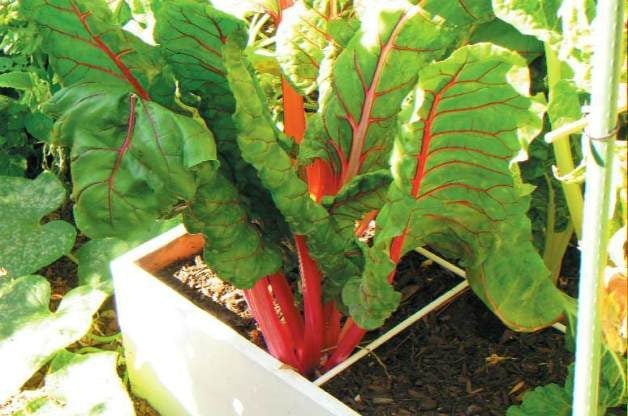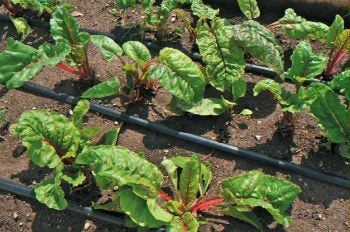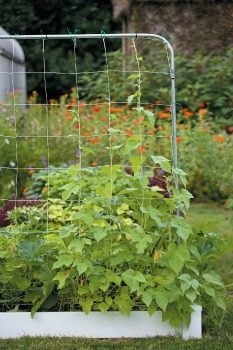Square Foot Gardening
Updated: Apr. 24, 2020

Make the most of your time and space with a smarter way to plant your garden.
What do you get when you combine the analytical brain of an engineer, the organizational tactics of an efficiency expert and the passion of a vegetable gardener? A little something called square-foot gardening, that’s what! A cutting-edge way to plan and plant, it makes the most of your space and cuts down on work. Sounds like a busy gardener’s dream. Developed by Mel Bartholomew after years of work in community gardens, the method is simple and versatile, making it the perfect choice for beginners and experts alike.
Square-Foot Gardening 101
In its most basic form, a square-foot garden is a 4-foot-by-4-foot raised bed garden divided into 16 squares, with each square measuring 12 by 12 inches. You plant a specific crop within each of the 12-inch squares, rather than in rows.
Small-growing crops, such as lettuce or peppers, occupy a single square or two, while larger crops, like tomatoes and corn, can take up multiple squares. Trellises at the end of a bed support vining crops.
Beds can be made any length, but should be kept to no more than 4 feet wide. This allows easier access to the garden. Most people can reach halfway across the bed from either side for easy planting, weeding and harvesting.
If you plan to use multiple beds, it’s a good idea to make sure you leave paths between each so you can have access from either side. These paths, and the limited width of each bed, make it unnecessary to step into the beds-thus avoiding two dreaded words no gardener worth his or her green thumb wants to hear: soil compaction.
Let’s Begin With the Basics
Planning is a very important part of this system. A well-executed plan can result in a beautiful and productive garden that minimizes time spent on maintenance. Here are a few basics to keep in mind before you break ground.

LOCATION
If you’re just getting started, place your garden where it’ll get at least eight hours of sunlight. If it receives more than eight hours, even better.
SIZE
Decide how big you want your garden to be. At this point, a little reality check is beneficial. Are you growing just for your own consumption or are you planning on doing some freezing or canning? If you don’t know just yet, start with no more than one 4-foot-by-4-foot bed for each family member.
CONSTRUCTION
Build your own raised beds or buy a kit and assemble it. Raised beds put to rest any pre-existing soil issues because it’s a cinch to just fill them with a well-draining, premixed growing medium. In addition, raised beds require less bending when weeding or harvesting. The height can vary depending on the crops you plant. It can be as low as 3 inches for a salad garden, although a height of 8 to 12 inches is most common.
For material, naturally long-lasting woods, such as cedar or redwood, are fine choices. Other options include plastic lumber, vinyl and pressure-treated wood. The last bit of construction is to create the grid that divides the beds into 12-inch squares.
CROPS
Here comes the fun part: deciding which vegetables you’d like to grow! First, create a map that details what crop, including how many plants or seeds, you plan to put in each square. Next, devise a planting timeline based on your area’s average last spring and first fall frost dates. If planting seeds, take into account the “days to maturity” date on back of the seed packet.

SPACING
To determine how much room your plants need, consider the recommended space between each plant after thinning. You may even want to consider interplanting, which means incorporating fast-growing vegetables (such as radishes and leaf lettuces) among slow-growing varieties, which don’t need all of their allocated space right away. But by the time they do need the space, the quick-growing crop will be harvested and out of the way, providing more elbow room for the remaining plants.
PLANTING
Here’s a key item to remember: Sow seeds one at a time. The extra effort in single-sowing even the tiniest seeds pays big dividends later because there’s no need to thin seedlings.
CARE AND MAINTENANCE
Compared to traditional methods, square-foot gardening uses a smaller area. This results in less area for weeds to grow and more efficient watering. Use soaker hoses, or hand water with a wand. Ideally, walk by your garden each day to pull any weeds and keep an eye out for pests. If that’s not possible, be sure to spend time at least once a week in the garden.
HARVESTING AND REPLANTING
Harvest crops as needed or when mature. Once a square is empty, use hand tools to work in a little compost or a pinch of fertilizer before replanting the same crop or trying a new one altogether.